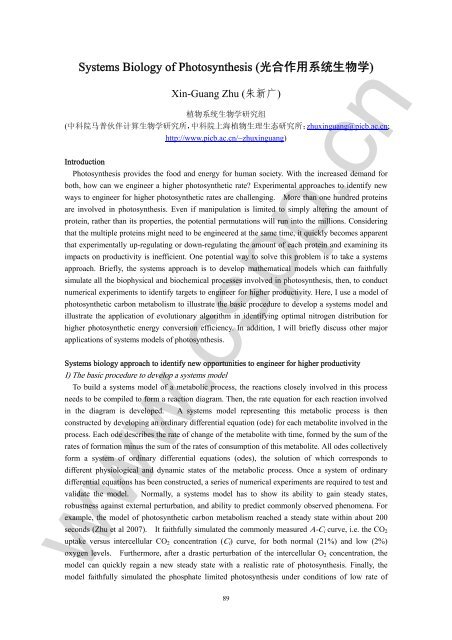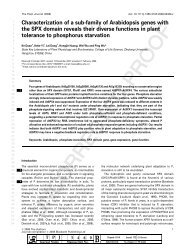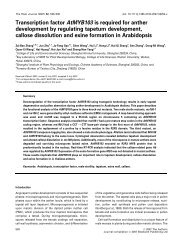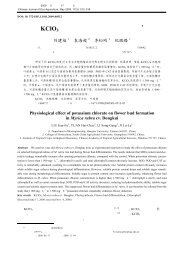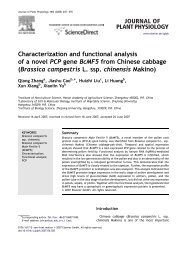Untitled - ä¸å½æ¤ç©ççä¸ååçç©å¦å¦ä¼
Untitled - ä¸å½æ¤ç©ççä¸ååçç©å¦å¦ä¼
Untitled - ä¸å½æ¤ç©ççä¸ååçç©å¦å¦ä¼
You also want an ePaper? Increase the reach of your titles
YUMPU automatically turns print PDFs into web optimized ePapers that Google loves.
Systems Biology of Photosynthesis ( 光 合 作 用 系 统 生 物 学 )<br />
Xin-Guang Zhu ( 朱 新 广 )<br />
植 物 系 统 生 物 学 研 究 组<br />
( 中 科 院 马 普 伙 伴 计 算 生 物 学 研 究 所 , 中 科 院 上 海 植 物 生 理 生 态 研 究 所 ;zhuxinguang@picb.ac.cn;<br />
Introduction<br />
http://www.picb.ac.cn/~zhuxinguang)<br />
Photosynthesis provides the food and energy for human society. With the increased demand for<br />
both, how can we engineer a higher photosynthetic rate? Experimental approaches to identify new<br />
ways to engineer for higher photosynthetic rates are challenging. More than one hundred proteins<br />
are involved in photosynthesis. Even if manipulation is limited to simply altering the amount of<br />
protein, rather than its properties, the potential permutations will run into the millions. Considering<br />
that the multiple proteins might need to be engineered at the same time, it quickly becomes apparent<br />
that experimentally up-regulating or down-regulating the amount of each protein and examining its<br />
impacts on productivity is inefficient. One potential way to solve this problem is to take a systems<br />
approach. Briefly, the systems approach is to develop mathematical models which can faithfully<br />
simulate all the biophysical and biochemical processes involved in photosynthesis, then, to conduct<br />
numerical experiments to identify targets to engineer for higher productivity. Here, I use a model of<br />
photosynthetic carbon metabolism to illustrate the basic procedure to develop a systems model and<br />
illustrate the application of evolutionary algorithm in identifying optimal nitrogen distribution for<br />
higher photosynthetic energy conversion efficiency. In addition, I will briefly discuss other major<br />
applications of systems models of photosynthesis.<br />
Systems biology approach to identify new opportunities to engineer for higher productivity<br />
I) The basic procedure to develop a systems model<br />
To build a systems model of a metabolic process, the reactions closely involved in this process<br />
needs to be compiled to form a reaction diagram. Then, the rate equation for each reaction involved<br />
in the diagram is developed.<br />
A systems model representing this metabolic process is then<br />
constructed by developing an ordinary differential equation (ode) for each metabolite involved in the<br />
process. Each ode describes the rate of change of the metabolite with time, formed by the sum of the<br />
rates of formation minus the sum of the rates of consumption of this metabolite. All odes collectively<br />
form a system of ordinary differential equations (odes), the solution of which corresponds to<br />
different physiological and dynamic states of the metabolic process. Once a system of ordinary<br />
differential equations has been constructed, a series of numerical experiments are required to test and<br />
validate the model.<br />
Normally, a systems model has to show its ability to gain steady states,<br />
robustness against external perturbation, and ability to predict commonly observed phenomena. For<br />
example, the model of photosynthetic carbon metabolism reached a steady state within about 200<br />
www.cspp.cn<br />
seconds (Zhu et al 2007). It faithfully simulated the commonly measured A-C i curve, i.e. the CO 2<br />
uptake versus intercellular CO 2 concentration (C ) i curve, for both normal (21%) and low (2%)<br />
oxygen levels. Furthermore, after a drastic perturbation of the intercellular O 2 concentration, the<br />
model can quickly regain a new steady state with a realistic rate of photosynthesis. Finally, the<br />
model faithfully simulated the phosphate limited photosynthesis under conditions of low rate of<br />
89


